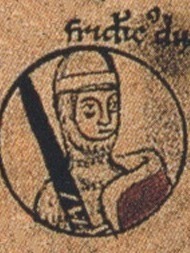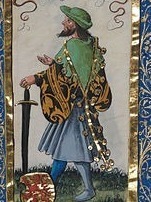Arbre généalogique Snelder - Versteegh » Countess Agnes of Hohenstaufen (1176-1204)
Données personnelles Countess Agnes of Hohenstaufen
- Elle est née en l'an 1176.
- Elle est décédée en l'an 1204, elle avait 28 ans.
- Un enfant de Conrad of Hohenstaufen et Irmengard of Henneberg
Famille de Countess Agnes of Hohenstaufen
Elle est mariée avec Henry V of Palatinate.
Ils se sont mariés
Enfant(s):
Notes par Countess Agnes of Hohenstaufen
https://en.wikipedia.org/wiki/Agnes_of_Hohenstaufen
Agnes of Hohenstaufen (1176 – 7 or 9 May 1204) was the daughter and heiress of the Hohenstaufen count palatine Conrad of the Rhine. She was Countess of the Palatinate herself from 1195 until her death, as the wife of the Welf count palatine Henry V.
Agnes' father Conrad of Hohenstaufen was a younger half-brother of Emperor Frederick Barbarossa, who had enfoffed him with the Electoral Palatinate in 1156. A cautious and thoughtful politician, he aimed for peace and reconciliation in the Empire. Even before 1180, he had betrothed his daughter to Henry V, the eldest son of the rebellious Saxon duke Henry the Lion, in order to defuse the re-emerging conflict between the Hohenstaufen and Welf dynasties.
In 1193, however, Barbarossa's son and successor, Emperor Henry VI, wanted to create a political alliance with King Philip II of France and planned to marry his cousin Agnes to Philip II. When the young Welf scion Henry V heard of this plan, he contacted Agnes' parents. Her father avoided definitive statements on her bethrothal, as he preferred a marriage with the French king, but also did not want to offend Henry V, whom Agnes revered fanatically.
Agnes' mother Irmengard (d. 1197), daughter of Count Berthold I of Henneberg, continued to advocate her daughter's marriage with the Welf prince. A little later she took advantage of the absence of her husband, who stayed at Henry VI's court, to thwart the Emperor's plan. She invited the young Welf to Stahleck Castle, where he and Agnes were married in January or February 1194.[1]
Furious Emperor Henry VI felt betrayed and demanded that Conrad immediately annul the marriage. Conrad, however, dropped his initial resistance to the marriage and, seeing as it had already been blessed in Church, chose to convince his nephew Henry VI of the domestic political benefits of this marriage. Conrad's sons had died young and Henry VI could assure the succession in the Electoral Palatinate by enfeoffing Henry the Welf. Additionally, Conrad and Agnes on the occasion of the marital union convinced the emperor to pardon Henry the Lion, who had been deposed and outlawed by Frederick Barbarossa in 1180.
The reconciliation between Emperor Henry VI and Duke Henry the Lion was solemnly held in March 1194 at the Imperial Palace of Tilleda. Agnes and her husband Henry V had done their bit to prepare for this major domestic event with their unscheduled marriage at Stahleck Castle. Moreover, Emperor Henry VI had to settle the conflict with the House of Welf, to ensure peace in the Holy Roman Empire while enforcing his claims on the Kingdom of Sicily after the death of King Tancred on 20 February 1194.
Agnes and Henry had a son and two daughters:
- Henry, was Count Palatine of the Rhine from 1212 to 1214
- Irmengard (1200–1260), married Herman V, Margrave of Baden-Baden
- Agnes (1201–1267), married Duke Otto II of Bavaria. Agnes and Otto became the ancestors of the House of Wittelsbach in Bavaria and the Palatinate. Her daughter Elisabeth was the mother of Conradin. Her son Louis was the father of Emperor Louis IV.
Legacy[edit]
During the Romanticism period in the 19th century, the historic picture of Agnes of Hohenstaufen was blissfully idelalized. In Christian Dietrich Grabbe's drama entitled Henry VI, published in 1830, she is depicted as a carefree but resolute girl, who even addresses the Imperial Diet to assert her marriage with the man she loves. Fighting for the love and happiness of her reluctant fiancé, she brings about the ultimate reconciliation of the Welf and Hohenstaufen families on the deathbed of her father-in-law, Henry the Lion, who called her "a rose blossoming between to rocks". In fact, it was Agnes' mother Irmengard who had arranged the marriage.
The opera Agnes of Hohenstaufen by the Italian composer Gaspare Spontini, based on the libretto by Ernst Raupach, had its premiere on 12 June 1829 at the Royal Opera Berlin.
Barre chronologique Countess Agnes of Hohenstaufen
 grand-parents
grand-parents
 parents
parents
 frères/soeurs
frères/soeurs
 enfants
enfants
Ancêtres (et descendants) de Agnes of Hohenstaufen
Agnes of Hohenstaufen | ||||||||||||||||||||||||||||||||||
Henry V of Palatinate | ||||||||||||||||||||||||||||||||||
Parenté Countess Agnes of Hohenstaufen
- Agnes of Hohenstaufen est la arrière(x51)-petite-fille de Titus Manlius Imperiosus Torquatus:Titus Manlius Imperiosus TorquatusTitus Manlius TorquatusTitus Manlius TorquatusAulus Manlius TorquatusTitus Manlius TorquatusDecimus Junius Silanus ManlianusMarcus Junius Silanus consulMarcus Junius SilanusMarcus Junius Silanus consulMarcus Junius SilanusJunia Calvina EquitusGaius SallustiusGaius Ummidius Quadratus SallustiusGaius Ummidius Quadratus Annianus VerusGaius Ummidius Quadratus Annianus Verus FulviusUmmidia Commificia AntoniaPendania Pedanius FuscusMariana MinorAurelia PompeianaClaudiaConstantius I Chlorus of RomeUnkownProcopius UsurperProcopiusProcopius II Magister Militum of ByzantiumProcopius Anthemius I of the of the Western Roman EmpireAlypia Princess of the of RomeCaratene Agrippina of NarbonneClothilde of BurgundyChlothar I of the FranksChilperic I of the FranksChlotar II of the FranksDagobert I of AustrasiaSigebert III of AustrasiaDagobert II Of AustrasiaSigebert IV of RazeSigebert V of RazeThierry IV of ToulouseAdalhelm of AutunWaldrada of AutunOdo of OrléansGebhard I of LahngauUdo I of LahngauManfred I of MetzHildegard of MetzEberhard IV of NordgauHugo V of EgisheimHugo VI of EgisheimGerard I of EgisheimHildegard of Egisheim-DagsburgFrederick of SwabiaFrederick II of SwabiaConrad of HohenstaufenAgnes of Hohenstaufen
Les données affichées n'ont aucune source.
Des liens dans d'autres publications
On rencontre cette personne aussi dans la publication:Sur le nom de famille Of Hohenstaufen
- Afficher les informations que Genealogie Online a concernant le patronyme Of Hohenstaufen.
- Afficher des informations sur Of Hohenstaufen sur le site Archives Ouvertes.
- Trouvez dans le registre Wie (onder)zoekt wie? qui recherche le nom de famille Of Hohenstaufen.
Roel Snelder, "Arbre généalogique Snelder - Versteegh", base de données, Généalogie Online (https://www.genealogieonline.nl/stamboom-snelder-versteegh/I506919.php : consultée 13 juin 2024), "Countess Agnes of Hohenstaufen (1176-1204)".


